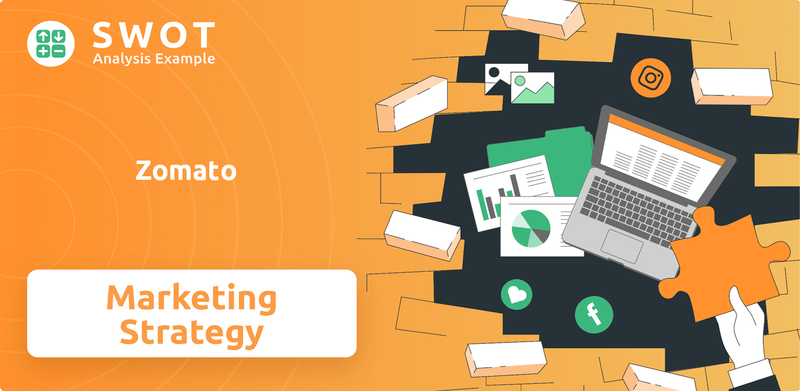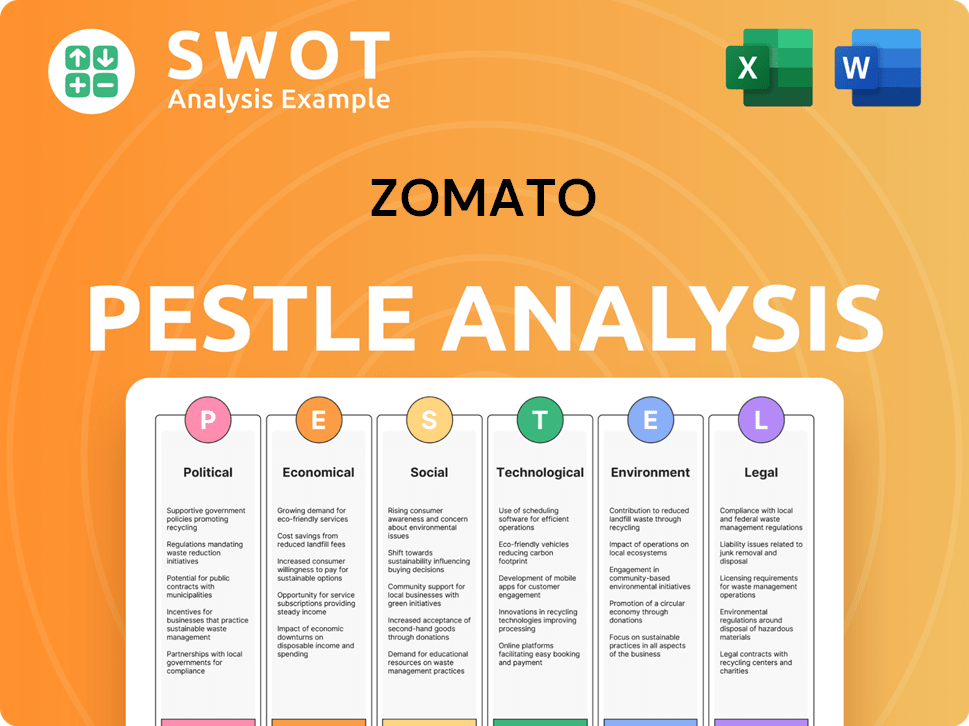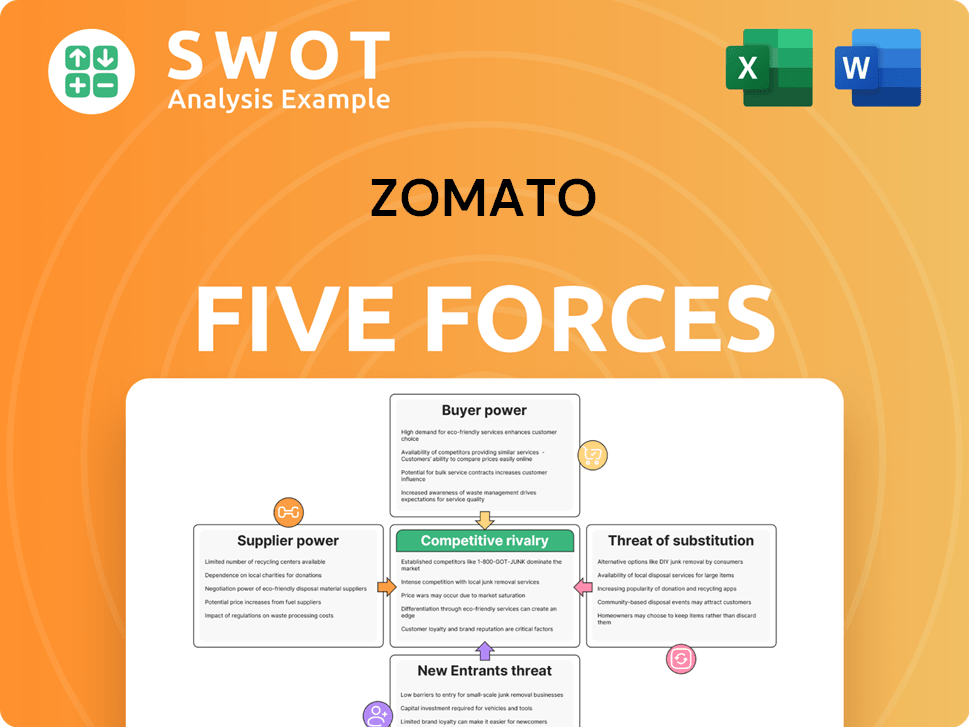Zomato Bundle
How has Zomato conquered the food tech world?
From its humble beginnings as a restaurant directory, Zomato has transformed into a food delivery and quick commerce giant. This evolution is a masterclass in strategic adaptation, fueled by innovative Zomato SWOT Analysis and a keen understanding of consumer needs. But what are the secrets behind Zomato's impressive growth and market dominance?

This exploration dives deep into Zomato's dynamic sales and marketing strategies, revealing how they've navigated the competitive food delivery market. We'll dissect their Zomato sales strategy, marketing tactics, and business model, alongside an analysis of their Zomato competitors and the digital marketing tactics that have propelled them to the forefront of online food ordering. Discover the key campaigns, customer acquisition strategies, and revenue generation model that have solidified Zomato's position.
How Does Zomato Reach Its Customers?
The sales strategy of Zomato heavily relies on digital platforms, particularly its mobile app and website. These platforms serve as the primary channels for online food ordering and restaurant discovery, allowing direct access to menus, user reviews, and order placement. This online-first approach is central to its business model, enabling a wide reach and efficient service delivery.
Zomato's strategy has evolved from restaurant discovery to a dominant food delivery service, driven by the increasing demand for online food ordering. The company's delivery executives play a crucial role in this channel, ensuring timely and efficient order fulfillment. Recent innovations, such as 'Intercity Food Delivery (Zomato Legends),' further expand its revenue streams by targeting niche audiences and offering premium services.
Strategic partnerships and acquisitions have been instrumental in Zomato's growth and market share. The acquisition of Blinkit in 2022 expanded its offerings to include rapid grocery delivery, a move that significantly boosted revenue. Additionally, Zomato's B2B supplies arm, Hyperpure, strengthens its ecosystem by providing fresh ingredients to restaurant partners. These moves showcase Zomato's commitment to diversifying its revenue streams and integrating an omnichannel approach.
The mobile app and website are the primary e-commerce platforms for Zomato, facilitating restaurant discovery and online food ordering. These platforms provide customers with access to menus, reviews, and direct ordering capabilities. This digital focus is key to Zomato's business model and customer reach.
Zomato's extensive network of delivery executives is crucial for timely and efficient order fulfillment. This network supports its core food delivery service, which is a significant revenue driver. The company's delivery network strategy is a key component of its operational success.
This service allows customers to order iconic food from different cities, opening new revenue streams through higher delivery fees. It targets niche audiences and enhances Zomato's service offerings. This expansion is part of Zomato's growth hacking techniques.
The acquisition of Blinkit expanded Zomato's offerings into rapid grocery delivery. Blinkit's revenue grew by 129% year-on-year in Q2 FY25. The company plans to reach 2,000 stores by December 2025, primarily in top Indian cities. This integration is a key part of Zomato's expansion strategies in new markets.
Zomato's partnerships and acquisitions, such as Blinkit, have significantly contributed to its market share. The B2B arm, Hyperpure, supplies fresh ingredients to restaurant partners, strengthening relationships and the ecosystem.
- Blinkit's revenue rose by 129% year-on-year in Q2 FY25.
- Hyperpure provides fresh ingredients to restaurant partners.
- The 'Going Out' segment revenue nearly tripled to Rs 259 crore in Q3 FY25 from Rs 73 crore in Q3 FY24.
- The District app, launched in November 2024, has over 6.5 million downloads.
Zomato SWOT Analysis
- Complete SWOT Breakdown
- Fully Customizable
- Editable in Excel & Word
- Professional Formatting
- Investor-Ready Format

What Marketing Tactics Does Zomato Use?
The marketing tactics of Zomato are heavily geared towards digital channels to build brand awareness, generate leads, and drive sales. Their comprehensive approach includes search engine optimization (SEO), paid advertising, social media marketing, content marketing, email marketing, and influencer partnerships. This multi-faceted strategy is crucial for maintaining a competitive edge in the food delivery market.
Zomato's digital-first strategy is designed to reach its target audience effectively. By leveraging various online platforms and techniques, they aim to enhance user engagement and drive conversions. The company's data-driven approach, customer segmentation, and personalization are highly sophisticated, ensuring that marketing efforts are relevant and engaging.
Zomato's marketing campaigns are designed to increase visibility and drive user engagement. The company uses a variety of digital marketing tactics to reach its target audience, including search engine optimization (SEO), paid advertising, social media marketing, content marketing, email marketing, and influencer partnerships. These tactics are essential for maintaining a competitive advantage in the online food ordering industry.
Zomato focuses on search engine optimization (SEO) to improve its search rankings. As of August 2023, they ranked for over 2.4 million keywords in India. They target keywords related to food, online ordering, and restaurant names to drive organic traffic.
Paid advertising is a key component of the Zomato marketing strategy. They run Google Ads campaigns, including search ads for transactional queries and display ads. These efforts are designed to generate brand awareness and drive traffic to the platform.
Social media marketing is a cornerstone of Zomato's approach. They maintain an active presence on platforms like Facebook, Twitter, and Instagram. Zomato uses viral campaigns and user-generated content to enhance brand recognition and engage with their audience.
Content marketing includes engaging blog posts and videos about food trends and local cuisines. For example, their Mother's Day 2024 campaign boosted viewership and brand awareness. This strategy helps to attract and retain customers.
Email marketing is used to deliver personalized recommendations and exclusive offers. Zomato segments its email lists to tailor messages based on user preferences. This approach helps to drive user retention, with open rates surpassing 60%.
Influencer partnerships are crucial for enhancing brand exposure and connecting with the target audience. Zomato often utilizes regional languages for hyper-local marketing. This helps to reach a wider audience.
Zomato's approach to data-driven marketing, customer segmentation, and personalization is highly sophisticated. They analyze user behavior to track campaign performance and optimize their marketing strategy. Technologies like AI and machine learning algorithms are increasingly leveraged to optimize delivery routes, predict demand, personalize recommendations, and adjust platform fees and delivery charges based on real-time factors. This ensures marketing efforts are relevant and engaging.
- Zomato uses data to enhance the user experience with hyper-personalized recommendations.
- They leverage AI and machine learning for predictive demand forecasting.
- The target audience primarily consists of tech-savvy individuals aged 18-35 seeking convenient dining options.
- The company's focus on digital channels and data-driven strategies is a key aspect of its Growth Strategy of Zomato.
Zomato PESTLE Analysis
- Covers All 6 PESTLE Categories
- No Research Needed – Save Hours of Work
- Built by Experts, Trusted by Consultants
- Instant Download, Ready to Use
- 100% Editable, Fully Customizable

How Is Zomato Positioned in the Market?
The brand positioning of Zomato focuses on creating a holistic ecosystem for culinary experiences, going beyond just food delivery. It aims to be a platform for exploration, convenience, and an enhanced dining experience. The company's approach is characterized by a playful and bold tone, which is consistently applied across all its communications and marketing efforts.
Zomato distinguishes itself from competitors in the food delivery market through its comprehensive offerings and focus on customer satisfaction and engagement. They offer an extensive database of restaurants, menus, and user reviews, empowering users to make informed decisions. The user-friendly interface and efficient delivery services are key competitive advantages, especially for tech-savvy millennials and Gen Z users.
Zomato's marketing strategy emphasizes value and loyalty through programs like Zomato Gold, which provides members with discounts and exclusive offers. This strategy not only ensures customer loyalty but also provides a consistent revenue stream. The company actively seeks feedback and maintains 24/7 customer support, leading to improved customer satisfaction. For a deeper understanding of their financial structure, see Revenue Streams & Business Model of Zomato.
The brand uses a playful, conversational, and bold tone of voice to connect with consumers. This approach makes the brand feel like a 'friend who understands your cravings.' This is a key element of their Zomato sales strategy.
Zomato differentiates itself through its comprehensive offerings, including an extensive database of restaurants and user reviews. Its user-friendly interface and efficient delivery services are key competitive advantages in the online food ordering market.
Zomato Gold, relaunched in early 2023, offers members discounts, free delivery, and exclusive offers. The company reported attracting over 2 million subscribers to its Zomato Gold program in the first quarter of 2024 alone. This is a key element of Zomato's marketing strategy.
Zomato actively solicits feedback and maintains 24/7 customer support, which has led to a 30% decrease in response time to inquiries. As of 2024, Zomato reported a 4.8/5 average customer rating. This focus improves user experience optimization.
Brand consistency is maintained through a minimalist branding approach across all channels. Zomato also engages in brand activism, promoting inclusivity in the food industry. The potential corporate rebranding to 'Eternal' in 2025 reflects its diversification.
- Zomato's minimalist branding approach ensures its logo and design elements are versatile.
- The company uses its platform for social good through initiatives like 'Feeding India.'
- The strategic shift in 2025 aims to reflect its diversified business portfolio.
- This expansion includes food delivery, quick commerce, B2B supplies, logistics, and financial services.
Zomato Business Model Canvas
- Complete 9-Block Business Model Canvas
- Effortlessly Communicate Your Business Strategy
- Investor-Ready BMC Format
- 100% Editable and Customizable
- Clear and Structured Layout

What Are Zomato’s Most Notable Campaigns?
The success of Zomato's sales and marketing strategy hinges on several key campaigns designed to boost brand recognition, customer engagement, and market share. These campaigns are multifaceted, incorporating digital marketing, customer loyalty programs, strategic partnerships, and innovative social media tactics. The firm's approach is data-driven, constantly evolving to meet the changing demands of the food delivery market and maintain a competitive edge.
One of the most effective strategies is its use of meme marketing. By transforming everyday situations into shareable memes, Zomato has successfully engaged its audience on platforms like Facebook, Twitter, and Instagram. This tactic allows them to stay relevant and generate user-generated content, enhancing brand recognition. Another key aspect of its strategy involves video marketing, often using short, unskippable video commercials on platforms like YouTube.
Beyond direct advertising, Zomato leverages loyalty programs and gamification to drive engagement and retention. The Zomato Gold subscription service, relaunched in early 2023 and expanded in 2024, offers perks like discounts and free delivery to incentivize repeat usage and foster long-term customer loyalty. In 2024, Zomato also introduced a scheme to offer points to customers for ordering food or writing reviews, which could be redeemed for rewards, creating a gamified experience. Referral programs have also been successful, with Zomato acquiring over 1.5 million new users in 2024 through such initiatives.
Zomato's meme marketing strategy leverages humor and relatability to enhance brand recognition and engage its audience. This approach keeps the brand relevant on trending topics and encourages user-generated content. This method has been crucial in maintaining a strong social media presence.
Video marketing, particularly through short, unskippable commercials on YouTube, is another key strategy. A notable example is their Mother's Day 2024 campaign, which increased viewership and brand awareness by incorporating memes and popular dialogues. This strategy aims to increase brand reach.
Targeted advertising campaigns are deployed on platforms like Facebook, Instagram, and Google to generate brand awareness and drive organic traffic to the app and website. Search ad campaigns, using Google Adwords, target transactional queries to convert leads into paying customers. This is a key element of their Growth Strategy of Zomato.
Loyalty programs, such as Zomato Gold (relaunched in 2023), offer discounts and free delivery to incentivize repeat usage. The introduction of a points-based reward system in 2024, where users earn points for orders and reviews, creates a gamified experience. Referral programs have also played a significant role in user acquisition.
Partnerships with restaurants, food bloggers, and influencers are critical for boosting brand visibility and credibility. Hyper-local marketing efforts resonate with diverse audiences, enhancing market penetration and brand awareness. These collaborations help in expanding the reach of the firm.
Zomato frequently collaborates with both macro and micro-influencers to boost brand visibility and credibility. This approach is particularly effective in hyper-local marketing efforts, helping them connect with diverse audiences and drive engagement. These partnerships are key for their marketing campaigns analysis.
Referral programs were instrumental in acquiring over 1.5 million new users in 2024. The company focuses on Zomato's customer acquisition strategies to expand its user base. This is a key focus area for growth within the competitive food delivery market.
The potential corporate rebranding to 'Eternal' in 2025 signals a shift to a diversified tech-driven ecosystem. This forward-looking approach aims to broaden market perception beyond food delivery. This indicates an evolution in Zomato's business model.
Zomato employs a variety of digital marketing tactics, including display ads on various platforms and search ad campaigns on Google Adwords. These strategies are designed to generate brand awareness and drive organic traffic. This helps Zomato's digital marketing tactics reach a wider audience.
Zomato's strategies are aimed at maintaining and increasing its market share in India. Expansion strategies in new markets are also a focus, with the goal of growing its user base and revenue. The goal is to establish a strong position within the online food ordering industry.
Zomato Porter's Five Forces Analysis
- Covers All 5 Competitive Forces in Detail
- Structured for Consultants, Students, and Founders
- 100% Editable in Microsoft Word & Excel
- Instant Digital Download – Use Immediately
- Compatible with Mac & PC – Fully Unlocked

Related Blogs
- What are Mission Vision & Core Values of Zomato Company?
- What is Competitive Landscape of Zomato Company?
- What is Growth Strategy and Future Prospects of Zomato Company?
- How Does Zomato Company Work?
- What is Brief History of Zomato Company?
- Who Owns Zomato Company?
- What is Customer Demographics and Target Market of Zomato Company?
Disclaimer
All information, articles, and product details provided on this website are for general informational and educational purposes only. We do not claim any ownership over, nor do we intend to infringe upon, any trademarks, copyrights, logos, brand names, or other intellectual property mentioned or depicted on this site. Such intellectual property remains the property of its respective owners, and any references here are made solely for identification or informational purposes, without implying any affiliation, endorsement, or partnership.
We make no representations or warranties, express or implied, regarding the accuracy, completeness, or suitability of any content or products presented. Nothing on this website should be construed as legal, tax, investment, financial, medical, or other professional advice. In addition, no part of this site—including articles or product references—constitutes a solicitation, recommendation, endorsement, advertisement, or offer to buy or sell any securities, franchises, or other financial instruments, particularly in jurisdictions where such activity would be unlawful.
All content is of a general nature and may not address the specific circumstances of any individual or entity. It is not a substitute for professional advice or services. Any actions you take based on the information provided here are strictly at your own risk. You accept full responsibility for any decisions or outcomes arising from your use of this website and agree to release us from any liability in connection with your use of, or reliance upon, the content or products found herein.